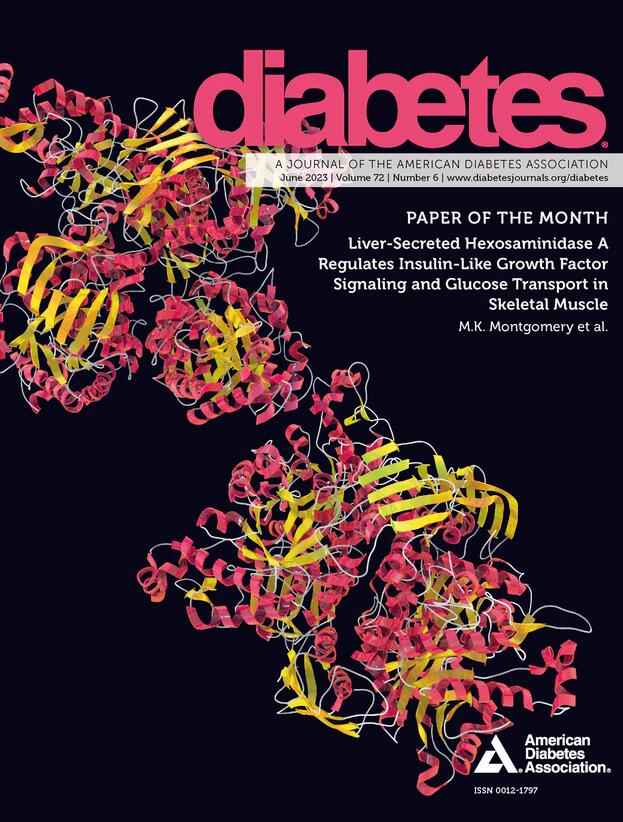1640-P:在糖尿病小鼠模型中靶向组织蛋白酶L治疗肝纤维化的机制和治疗潜力
IF 6.2
1区 医学
Q1 ENDOCRINOLOGY & METABOLISM
引用次数: 0
摘要
简介和目的:糖尿病与非酒精性脂肪性肝病(NAFLD)密切相关,2型糖尿病显著增加NAFLD的风险。我们之前的研究发现,溶酶体酶组织蛋白酶L (CTSL)在糖尿病患者中上调,高葡萄糖水平激活CTSL功能(PMID: 39150053)。值得注意的是,CTSL可能裂解Collagen18A1生成内皮抑素,激活肝星状细胞,加速纤维化。方法:我们开发了一种新的CTSL抑制剂,该抑制剂专门针对CTSL,副作用最小。探讨CTSL在肝纤维化中的作用及机制。结果:高糖诱导人肝癌细胞CTSL成熟(Huh7)。葡萄糖处理的Huh7细胞条件培养基激活人肝星状细胞(LX-2),增加I型胶原和αSMA的表达。在db/db糖尿病小鼠肝纤维化模型中,HE染色评估组织结构和病理改变,Sirius红染色评估纤维化严重程度,F4/80免疫组化评估炎症浸润。使用CTSL抑制剂治疗可显著改善肝脏组织学,减少纤维化和炎症。结论:CTSL抑制剂可有效减轻db/db糖尿病小鼠的纤维化和炎症,显示其作为NAFLD治疗药物的潜力。李先生:没有。赵先生:没有。杨:没有。国家自然科学基金(82341076)资助本文章由计算机程序翻译,如有差异,请以英文原文为准。
1640-P: Targeting Cathepsin L for Liver Fibrosis—Mechanistic Insights and Therapeutic Potential in a Diabetic Mouse Model
Introduction and Objective: Diabetes and non-alcoholic fatty liver disease (NAFLD) are closely linked, with type 2 diabetes markedly increasing the risk of NAFLD. Our prior research identified the lysosomal enzyme Cathepsin L (CTSL) as upregulated in diabetic patients, with high glucose levels activating CTSL function (PMID: 39150053). Notably, CTSL may cleave Collagen18A1 to generate endostatin, which activates hepatic stellate cells and accelerates fibrosis. Methods: We developed a novel CTSL inhibitor that specifically targets CTSL with minimal side effects. The role and mechanism of CTSL in liver fibrosis were investigated. Results: High glucose induced CTSL maturation in human hepatocellular carcinoma cells (Huh7). Conditioned media from glucose-treated Huh7 cells activated human hepatic stellate cells (LX-2), increasing the expression of Collagen I and αSMA. In a db/db diabetic mouse model of liver fibrosis, tissue structure and pathological changes were assessed using HE staining, fibrosis severity by Sirius red staining, and inflammation infiltration by F4/80 immunohistochemistry. Treatment with the CTSL inhibitor significantly improved liver histology, reducing fibrosis and inflammation. Conclusion: The CTSL inhibitor effectively alleviated fibrosis and inflammation in db/db diabetic mice, highlighting its potential as a therapeutic agent for NAFLD. Disclosure M. Li: None. M. Zhao: None. J. Yang: None. Funding National Natural Science Foundation of China (82341076)
求助全文
通过发布文献求助,成功后即可免费获取论文全文。
去求助
来源期刊

Diabetes
医学-内分泌学与代谢
CiteScore
12.50
自引率
2.60%
发文量
1968
审稿时长
1 months
期刊介绍:
Diabetes is a scientific journal that publishes original research exploring the physiological and pathophysiological aspects of diabetes mellitus. We encourage submissions of manuscripts pertaining to laboratory, animal, or human research, covering a wide range of topics. Our primary focus is on investigative reports investigating various aspects such as the development and progression of diabetes, along with its associated complications. We also welcome studies delving into normal and pathological pancreatic islet function and intermediary metabolism, as well as exploring the mechanisms of drug and hormone action from a pharmacological perspective. Additionally, we encourage submissions that delve into the biochemical and molecular aspects of both normal and abnormal biological processes.
However, it is important to note that we do not publish studies relating to diabetes education or the application of accepted therapeutic and diagnostic approaches to patients with diabetes mellitus. Our aim is to provide a platform for research that contributes to advancing our understanding of the underlying mechanisms and processes of diabetes.
 求助内容:
求助内容: 应助结果提醒方式:
应助结果提醒方式:


